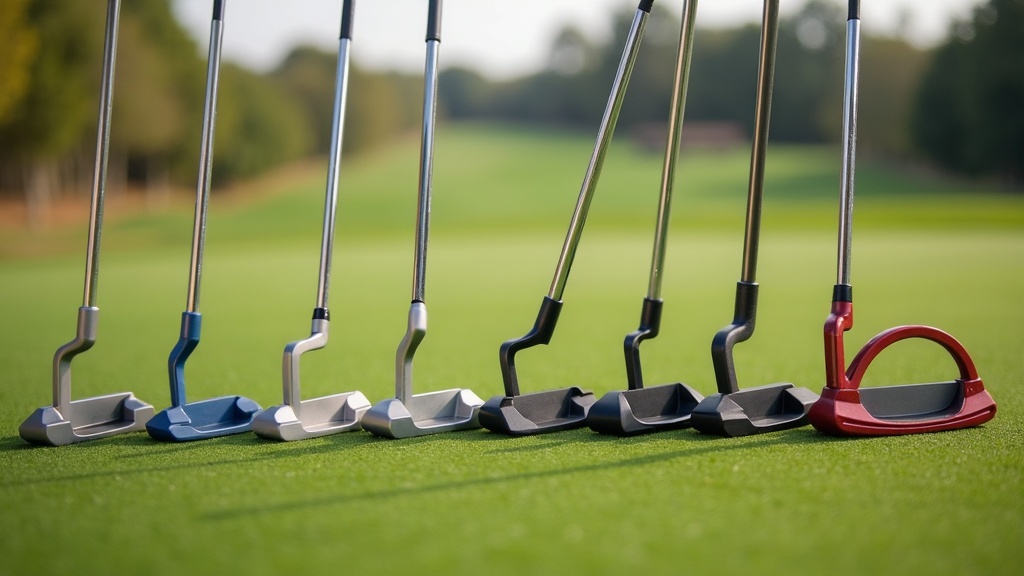If you’re eyeing lower scores or just want to shave a few strokes off your game, picking the right putter can make a world of difference. The putter is the club I rely on most, so finding one that matches your style, feels good in the hands, and fits your stroke really matters. To help you sort through all the latest releases and tech upgrades, I’ve put together my list of the top 10 best putters of 2024. I’ll also dig into features and benefits that might suit your putting style so you can hit the greens with more confidence.

Why Choosing the Right Putter Is Really Important
When I’m looking for a new putter, a bunch of questions run through my mind. Is it forgiving on those miss-hits? Does it feel comfortable? And will it actually help me roll the ball straighter? Getting a putter that fits your stroke style (arc, straight back and through, or something in between) and feels balanced for your grip is a game-changer. It’s not an exaggeration—the right putter can give a boost to your confidence from inside ten feet much faster than you’d expect.
Putter design has stepped up recently. Brands are rolling out new shapes, materials, and alignment aids that make lining up putts much simpler. Mallet putters keep growing in popularity, but classic blades still have a loyal following. Many golfers, myself included, have switched preferences over the years based on these improvements in tech and feel.
Even more, with so many eye-catching designs and finishes popping up, it’s easier than ever to find a putter that not only fits your stroke but matches your style and inspires confidence when you step over the ball.
The Top 10 Best Putters of 2024
I’ve tried a variety of putters this season and chatted with golfers of all skill levels. The choices below reflect a blend of cool tech, forgiveness, value, and plain rolling performance. There’s a solid option here whether you love bold technology or a more classic feel.
- Odyssey Ai-One Rossie S
This mallet delivers great stability and features a super intuitive alignment line. Odyssey’s AI-designed insert has a smooth yet firm feel that gives you excellent distance control. - Scotty Cameron Phantom X 5.5
The Phantom line always looks next-level cool, but this model stands out for its feedback and responsive roll. The midmallet shape works for all sorts of arc types, with a milled face producing a clean strike every time. - TaylorMade Spider GT Max
With adjustable weights and bold colors, the GT Max fits players who like to dial in feel and swing weight. The Pure Roll insert gives a soft touch, and it’s easy to line up, even on tricky greens. - Ping PLD Milled Anser
The Anser head shape is iconic, and in this latest PLD milled update, Ping nails the classic blade feel. It’s compact but still forgiving on misses, and the finish reduces glare under the sun. - EvNroll ER2v MidBlade
EvNroll’s groove tech locks in distance and direction consistency. Even off-center putts end up much closer to the hole than you’d expect—helpful when nerves show up. - Cleveland HB Soft 2 #11 Slant
If you’re looking for value without losing performance, give the HB Soft 2 a try. Its milled face, forgiving head, and balanced weight shine for mid- and high-handicappers. - Bettinardi BB28
Premium feel, impressive look, and buttery contact sum up the BB28. It mixes a modern mallet head with classic Bettinardi milling for total control on both short and long putts. - Mizuno M.CRAFT OMOI #1
Mizuno’s forged putters always stand out, and the extra head weight in the OMOI series smooths out your stroke. I love how pure the ball rolls off the face, and the stock headcover is classy as well. - SeeMore Mini Giant Deep Flange
Its RifleScope Technology (RST) alignment system makes this putter easy to square up to your target. It’s especially helpful if you often deal with misalignment issues. - Wilson Staff Model 8802
With a no-frills design, this blade is for those who want straight-up, classic performance. The soft carbon steel brings plenty of feel and feedback—excellent for touch putters who rely on finesse.
Key Features to Look For When Choosing a Putter
There’s a lot going on in the world of putters, but here are the features I always pay special attention to. Some might be more important than others depending on your stroke and preferences:
- Head Shape: Mallet, high MOI, and traditional blade putters all give different feel and performance perks. Mallets are usually easier to align, while blades give awesome feedback for players with hard arc strokes.
- Face Insert or Milling: Inserts can soften the feel and help cut down on skidding, while deep milled faces give that classic click and top-notch feedback. Some, like the EvNroll, use groove patterns to control launch and spin.
- Alignment Aids: Heavy lines, dots, or high-contrast graphics really help if you struggle to start the ball on line. Putter tech has gotten clever—just pick what your eyes trust.
- Weight and Balance: Adjustable weights and heel-toe weighting turn up stability and let you fine-tune the putter to match your pace.
- Length and Loft: Getting a putter in the right length for your setup makes it much easier to get your eyes over the ball. Loft helps set the putt rolling smooth instead of bouncing off the face.
When trying out putters, don’t forget to look for that feeling of balance in your hands. A putter that fits your personal setup will help you have more control and confidence in every stroke.
What Type of Putter is Right for Your Stroke?
Matching your putter to your stroke style helps you roll more putts online. Here’s a quick look at the basics:
- Straight back and through strokes: High MOI mallets and center shafted models usually work best, keeping the face square through impact.
- Strong arc strokes: Classic blades or toe hang mallets give you the leeway to open and close the face naturally.
- Slight arc: Plenty of midmallets bridge the gap, offering both stability and just enough toe hang.
Testing is the only sure way to lock down your preference, and many golf shops now have putting labs with tech that tracks your stroke. I’ve had better results narrowing my picks by trying out putters on different surfaces, both flat and sloped, to see how the ball reacts off each face and material.
Putter Materials and Build Quality
Putter feel comes down to the material used. Soft carbon steel brings a buttery touch, while stainless steel offers extra durability. Inserts may use rubber polymers, aluminum, or multiblend designs to adjust the sound and feel. Small differences in material can matter over several rounds, so it’s worth testing a few before you settle on the right one.
Some modern putters even blend several materials—like tungsten weights and aluminum bodies—to steady your stroke and up forgiveness, especially on tricky greens with various speeds.
Common Questions When Shopping for a New Putter
Picking out a putter can get overwhelming. These are the questions I get asked the most (and ones I wish I’d known the answers to when I shopped for my first putter):
Question: Should I go with a mallet or a blade putter?
Answer: Mallets are more stable and forgiving, making them popular with golfers looking for help with alignment and distance control. Blades offer more feedback and control for those with a steady, consistent stroke. Pick what feels best for you after trying both styles.
Question: How do I know if my putter is the right length?
Answer: Most golfers use putters between 33″ and 35″. The right length puts your eyes above the ball and helps you make a natural stroke. Try a few out in store or on the green to see which one matches your setup best.
Question: Are expensive putters really worth the cash?
Answer: Higher priced putters often show off advanced materials and more precise milling, which can mean better feel and consistency. But there are plenty of mid-range putters that roll just as true. The best putter is the one that sparks your confidence, no matter the price.
Real-World Tips for Getting the Most out of Your Putter
Once you’ve picked your putter, these practical tips can help you start seeing drops in your scores right away:
- Work on alignment: Use tees or alignment sticks to learn if your putter’s aid actually helps you aim correctly. Practice with these tools to spot and fix your setup on the putting green.
- Mind your grip: Try out different grip styles (such as claw or left hand low) to find what feels natural. Even the perfect putter may not perform if your grip isn’t steady and relaxed.
- Practice speed control: Distance drills are key. Getting the pace on lag putts just right is a big part of cutting down those tricky two putts during your round.
- Keep your putter clean: Clean grooves and a fresh face release the ball consistently. Keep a towel handy and wipe down your putter after each hole for best results.
- Play on different greens: Expose yourself to fast and slow greens, flat and sloped, so you can read breaks and learn how your new putter reacts on every surface.
It all comes down to picking a putter that gives you a feel for control and inspires confidence. Whether you lean classic or modern, the tech out now puts plenty of options on the table for every style and budget. Take time to try out different shapes, ask for demos, and don’t hesitate to check in with local pros for advice.
With new technology and custom fitting more available than ever, there’s truly never been a better time to upgrade your putter and fine-tune your skills on the greens.
Start testing out putters that catch your eye, focus on comfort and confidence, and enjoy the ride toward lower scores!
